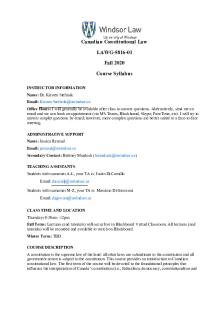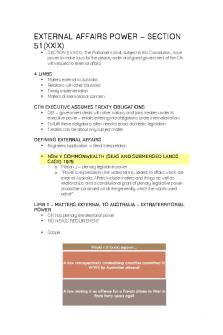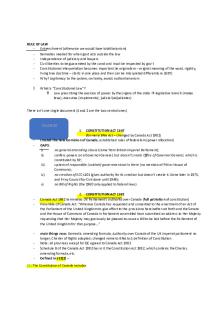LS1537 - UK Constitutional Law PDF

| Title | LS1537 - UK Constitutional Law |
|---|---|
| Course | UK constitutional law |
| Institution | University of Aberdeen |
| Pages | 6 |
| File Size | 161.1 KB |
| File Type | |
| Total Downloads | 95 |
| Total Views | 150 |
Summary
Lecture Notes ...
Description
UK Constitutional Law Lecture 1 - 14/1/2020 Constitutions What is a constitution? Broad (functional) definition: The rules that belong to a constitution can be identified by referring to the function of constitutions “The set of laws, rules and practices that create the basic institutions of the state, and its component and related parts, and stipulate the powers of those institutions and the relationship between the different institutions and between those institutions and the individual.” - House of Lords, Select Committee on Constitution, First Report Narrow definition: 1. Supremacy - The constitution is the supreme law of the land Example: 52(1) The Constitution of Canada is the supreme law of Canada, and any law that is inconsistent with the provisions of the Constitution is, to the extent of the inconsistency, of no force or effect
2. Entrenchment - The constitution is enacted in a special procedure -
Qualified majority Dedicated constitutional assembly Referendum Eternity clause - some provisions of the constitution cannot be changed at all (78)
3. Codification - The rules of the constitution can be found in one document -
Capital-C = Constitution Easy to identify what belongs to the constitution Clarifies which rules are supreme and entrenched
What are the functions of a constitution? 1. Constitute - they create new and establish constitutions 2. Limit - they limit the powers of the state, and the most important limit may be the right to limit the government’s power 3. Legitimise - This answers the questions of where does the authority of the constitution stem from? What is the purpose of the constitution? Who are we? And what do we stand for? The British constitution “The term British constitution is near meaningless.” (F.F. Ridley) In the functional sense the UK does have a constitution, however it completely depends on the definition used. What kind of constitution do we have?
The constitution that the UK has is: 1. Uncodified - The constitution is partly written, nut it is uncodified i.e. no single official text setting out the constitution. Britain has no capital-C Constitution and there is uncertainty as to what is and is not part of the constitution. To sum up, a constitution was never fully written 2. Unentrenched (flexible) - Constitution laws can be changed just as easily and in the same manner as ordinary laws (this function is changing). The lack of entrenchment is due to the parliamentary supremacy in the United Kingdom. Finally, the British Constitution is flexible; more flexible than other countries’ constitutions 3. No Supremacy - The constitutional laws in the UK have no special status; they have no priority over ordinary laws. However, for the time being, EU law has priority over domestic law. “The building has been constantly added to, patched and partially re-constructed, so that it has been renewed from century to century, but it has never been razed to the ground and rebuilt on new foundations. If a constitution consists of institutions and not of paper that describes them, the British Constitution has not been made but has grown - and there is no paper.” - Sir W.I. Jennings, The Law and the Constitution [1933] (5th edn, London: University of London Press, 1960) Modifying vs foundational Modifying - New constitutional rules impose limits on the authority of existing institutions, but that authority is not derived from or constituted by the new constitutional rules, e.g. 1688 Bill of Rights Foundational - The constitution is the only source of legitimate authority and creates all the institutions, e.g. US Constitution 1789 Political vs legal Political - The primary check on the government should be the political process Legal - The primary checks on the government should be judicially enforceable rights “What is beautiful about the British Constitution is that it uses politics as the vehicle through which the purpose of the constitution (that is, to check the government) may be accomplished. This is beautiful for at least two reasons: first, because it is democratic; and secondly, because it can actually work. Politics can really stop governments from abusing their authority.” - Adam Tomkins, Our Republican Constitution, (Hart 2005), pg 3 Constitutional Change
Lecture 2 - 17/1/2020
Sources of the Constitution What is a source of the constitution? The source is the origin of the rule; where it came from. It also mentions who the author of the rule is and who it is that confers authority on the rule. It is not a place to look up rules of the constitution - e.g. Westlaw is not a source of law Legal sources of the constitution - Legislation - International law - Judge-made law - Royal prerogative Non-legal sources of legislation - Works of authority - Conventions (e.g. Sewel Convention) ‘Written’ sources of the constitution - International law - Legislation - Royal prerogative ‘Unwritten’ sources of the constitution - Works of authority - Conventions - Judge-made law Domestic sources of the constitution - Legislation - Works of authority - Judge-made law - Royal prerogative - Conventions International sources of the constitution - International law Legislation
No capital-C Constitution The UK Constitution is partly written, but it is uncodified i.e. there is no single official text setting out the constitution. Britain has no capital-C Constitution and it also has no formal criterion to identify constitutional laws.
The functional definition must be used when considering the UK Constitution because there is uncertainty as to what is and is not part of the constitution. Institutions - Powers - Acts of Union - Devolved legislation - Acts of Parliament - House of Lords Act 1999 - Representation of the People Act 1983 - Constitutional Reform Act 2005 - European Communities Act 1972 Government - Individual - Magna Carta 1215 - Bill of Rights 1688 - Human Rights Act 1998 Legislative conflict - When there is conflict between constitutional laws and ordinary laws, the constitution prevails and is the source of law used. - When there is a conflict between two acts that are similar where one is older and one is more recent, the more recent Act prevails and is used as the source of law. Judge-made law Definition: Precedents created by judges in the course of deciding cases. They are sometimes binding on subsequent cases (stare decisis). Precedents are written but the rules they stand for do not have a canonical formulation. The rule that is established by a precedent can be formulated in different ways. - Interpreting legislation - s.3 of the Human Rights Act 1998 gives very strong power to judges - Self-contained body of law (Common law) - civil liberties The Royal Prerogative
Lecture 3 - 20/1/2020 The UK Parliament Three branches of government
There are three main branches of the government: - The Legislative - law making powers - The Executive - law applying/governing - The Judiciary - dispute resolution The fusion of powers Under the British Constitution the executive (the Her Majesty’s Government) is drawn from the legislature (Parliament); they are not a separately elected part of the government. Constitutional conventions - Ministers are drawn from parliament and are accountable to parliament for their actions. ‘A cabinet is a combining committee - a hyphen joins, a buckle which fastens, the legislative part of the State to the executive part of the State. In its origins it belongs to one, in its function belongs to the other.’ - Walter Bagehot, The English Constitution [1867] Functions of Parliament - Representative of the electorate and wider population - the Queen and the House of Lords are not representative of the electorate because they are not voted in. - Deliberative - It is a forum of debate to discuss issues of national importance - Scrutinises and holds Her Majesty’s Government to account - Makes laws Westminster Parliament ‘This is a free country and the Westminster parliament is one of the things which make it so. Parliament is a complex mechanism, but at its heart is a simple balance: the balance between enabling the Government to do things, and holding them to account - asking questions, proposing alternatives, forcing them to reveal information and justify their actions.’ - Joint Committee on Conventions, Report, Session 2005-06 The meeting of Parliament Parliament is now elected once every 5 years following the passing of the Fixed-term Parliaments Act 2011. Annual Sessions of Parliament begin in the spring and each Annual Session begins with the State Opening of Parliament and the Queen’s Speech.
The dissolution of Parliament Before each election, Parliament would be dissolved by the Queen - thereby ending its ‘life’ under the royal prerogative until this power was removed under the Fixed-term Parliaments Act 2011. A royal proclamation is then issued calling for the election of a new Parliament Before 2011, the Prime Minister had discretion within that 5 year period to ask the Monarch to dissolve Parliament at any time, thereby triggering an election.
House of Commons There are 650 Members of Parliament (MPs) 59 of which are Scottish seats. MPs are directly elected under the first-past-the-post system (FPTP). The House of Commons is chaired by the Speaker of the House - a politically impartial MP who is elected by MPs. The Speaker has the power to order proceedings within the House and to make sure that MPs follow the Rules of the House. Each MP represents a constituency containing roughly 70,000 people and revising the constituency boundaries is politically sensitive and done by the independent Boundary Commission (Parliamentary Constituencies Act 1986). Role of the House of Commons The role of the House of Commons is to represent the people in the passing of legislation and the scrutiny of Government. In particular, the House of Commons has ‘power of the purse’ and is responsible for authorising the taxation and expenditure sought by the Government - it ‘votes supply’ based on Government estimates and confirmed via a Consolidated Fund Bill enacted as an Appropriation Act. Government departmental spending is scrutinised by the Public Accounts Committee. Committees of the House of Commons Select committees were introduced in 1979 and there are currently 18 such committees in operation. Each committee oversees the work of a government department and scrutinises its policy and administration - e.g. House of Commons Home Affairs Committee - and their remits reflect departmental structures. Each committee has 11-16 backbench MPs as members and ever committee is cross-party - proportionate party balance. Select Committee Chairs have been elected by MPs in a secret ballot since 2010 - formerly selection was by part whips. Committees are inquisitorial in nature - they hear oral and written evidence, and can summon Ministers, civil servants and academic experts to give evidence. Governments are obliged to respond to committee reports but do not have to accept their recommendations purely advisory....
Similar Free PDFs

LS1537 - UK Constitutional Law
- 6 Pages

Constitutional Law
- 5 Pages

Constitutional law syllabus
- 13 Pages

Citizenship Constitutional Law Notes
- 10 Pages

Constitutional-Law-Flowchart
- 8 Pages

Constitutional Law model questions
- 42 Pages

Constitutional Law 4 limbs
- 7 Pages

Constitutional Law 1- Bernas
- 1,442 Pages

Constitutional Law Reviewer
- 227 Pages

Week 5- Constitutional Law
- 44 Pages

Constitutional Law Reviewer midterm
- 161 Pages

Australian Constitutional Law Notes
- 65 Pages

Constitutional LAW Outline
- 73 Pages

Constitutional Law Outline
- 30 Pages
Popular Institutions
- Tinajero National High School - Annex
- Politeknik Caltex Riau
- Yokohama City University
- SGT University
- University of Al-Qadisiyah
- Divine Word College of Vigan
- Techniek College Rotterdam
- Universidade de Santiago
- Universiti Teknologi MARA Cawangan Johor Kampus Pasir Gudang
- Poltekkes Kemenkes Yogyakarta
- Baguio City National High School
- Colegio san marcos
- preparatoria uno
- Centro de Bachillerato Tecnológico Industrial y de Servicios No. 107
- Dalian Maritime University
- Quang Trung Secondary School
- Colegio Tecnológico en Informática
- Corporación Regional de Educación Superior
- Grupo CEDVA
- Dar Al Uloom University
- Centro de Estudios Preuniversitarios de la Universidad Nacional de Ingeniería
- 上智大学
- Aakash International School, Nuna Majara
- San Felipe Neri Catholic School
- Kang Chiao International School - New Taipei City
- Misamis Occidental National High School
- Institución Educativa Escuela Normal Juan Ladrilleros
- Kolehiyo ng Pantukan
- Batanes State College
- Instituto Continental
- Sekolah Menengah Kejuruan Kesehatan Kaltara (Tarakan)
- Colegio de La Inmaculada Concepcion - Cebu

